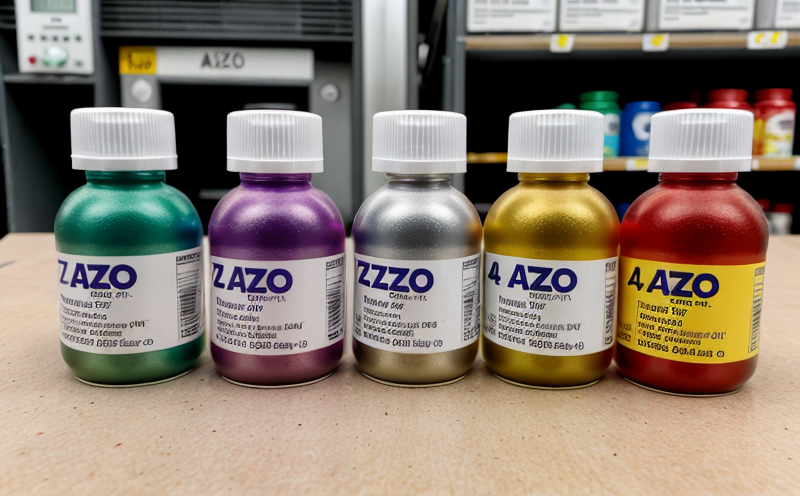UNI EN 14362 Detection of restricted amines from azo dyes
The UNI EN 14362 standard is essential for ensuring compliance with the EU's REACH regulation, which aims to protect human health and the environment by restricting the use of certain hazardous chemicals in textile products. This service focuses on detecting restricted amines derived from azo dyes present in textiles. Azo dyes are widely used in the textile industry due to their excellent fastness properties but can release harmful amines under specific conditions.
The primary goal of this testing is to identify potentially hazardous amines that may be released during wear, washing, or degradation processes. These amines, such as benzidine and o-toluidine, are classified as carcinogenic, mutagenic, and reprotoxic (CMR) substances under REACH regulations.
The methodology involves extracting the azo dyes from textile samples using an appropriate solvent, followed by hydrolysis to release the amines. The released amines are then quantified using high-performance liquid chromatography (HPLC) with UV detection or other suitable analytical techniques. This process ensures accurate and reliable results that can be used for compliance purposes.
Our state-of-the-art facilities, equipped with advanced instrumentation like HPLC systems from reputable manufacturers such as Shimadzu or Agilent, guarantee precise measurements and consistent quality across all tests. Compliance reports are provided promptly to help clients stay ahead of regulatory changes and maintain product integrity.
The importance of this service cannot be overstated in today's market where consumer demand for safe products is at an all-time high. By adhering to international standards like UNI EN 14362, manufacturers can ensure their products meet stringent safety requirements while avoiding costly recalls or legal actions due to non-compliance.
For those involved in the textile industry—whether as quality managers, compliance officers, R&D engineers, or procurement specialists—a clear understanding of how these tests are conducted and why they matter is crucial. This knowledge allows stakeholders to make informed decisions about product development and sourcing strategies that prioritize both safety and sustainability.
Scope and Methodology
Scope:
| Test Parameters | Description |
|---|---|
| Azo dye extraction | The process of separating azo dyes from the textile matrix using solvents like water or methanol. |
| Hydrolysis reaction | Conversion of azo bonds into free amines through acid treatment at elevated temperatures. |
| Amine quantification | Determination of the amount of released amines using HPLC with UV detection or alternative methods. |
Methodology:
- Samples are prepared according to ISO 17536 guidelines for textile sample preparation.
- Azo dyes are extracted using a solvent mixture containing water and methanol in a ratio of 2:1 by volume.
- The extraction solution is then heated to 80°C under nitrogen atmosphere for two hours to enhance extraction efficiency.
- After cooling down, the extracts are filtered through 0.45 micrometer filters before being analyzed further.
This comprehensive approach ensures thorough analysis and accurate detection of restricted amines in textiles, thereby ensuring compliance with relevant regulations.
Eurolab Advantages
- Advanced instrumentation from leading manufacturers like Shimadzu and Agilent for precise measurements.
- Experienced technicians who have extensive knowledge of UNI EN 14362 procedures.
- Prompt delivery of compliance reports to keep clients informed throughout the testing process.
- Comprehensive support services available to help navigate complex regulatory environments effectively.
Our commitment to excellence sets us apart from other laboratories, ensuring that every test conducted meets the highest standards of accuracy and reliability. Clients can trust Eurolab to provide reliable results that contribute towards maintaining their reputation for producing safe and compliant products.
Use Cases and Application Examples
| Use Case | Description |
|---|---|
| New product development | Detecting restricted amines early in the design phase helps prevent potential issues before full-scale production begins. |
| Sourcing raw materials | Assuring that purchased fabrics comply with UNI EN 14362 ensures seamless integration into existing manufacturing processes without disruptions. |
| Quality assurance audits | Regular testing allows companies to maintain consistent quality levels across all batches of production, reducing the risk of non-compliance incidents. |
| Compliance monitoring | Ongoing monitoring helps businesses stay abreast of any changes in legislation or industry best practices, allowing them to adapt quickly and effectively. |
Azo dyes are frequently used in various types of textiles including denim jeans, casual wear, sportswear, and work uniforms. Given their widespread application across multiple sectors, it's imperative that manufacturers comply with UNI EN 14362 to avoid legal penalties and maintain consumer trust.





